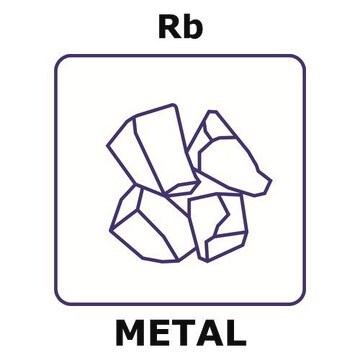276332
Rubidium
ingot, 99.6% trace metals basis
About This Item
Productos recomendados
assay
99.6% trace metals basis
form
ingot
reaction suitability
reagent type: reductant
packaging
pkg of Packaged in: Breakseal Ampule
resistivity
11.0 μΩ-cm, 20°C
impurities
0.2-0.4% Cs
bp
686 °C (lit.)
mp
38-39 °C (lit.)
density
1.53 g/mL at 25 °C (lit.)
SMILES string
[Rb]
InChI
1S/Rb
InChI key
IGLNJRXAVVLDKE-UHFFFAOYSA-N
¿Está buscando productos similares? Visita Guía de comparación de productos
Categorías relacionadas
General description
Application
It can also be used as a reducing agent to synthesize reduced polycyclic aromatic hydrocarbons.
signalword
Danger
hcodes
Hazard Classifications
Eye Dam. 1 - Skin Corr. 1B - Water-react 1
supp_hazards
Storage Class
4.3 - Hazardous materials which set free flammable gases upon contact with water
wgk_germany
WGK 3
flash_point_f
Not applicable
flash_point_c
Not applicable
ppe
Eyeshields, Faceshields, Gloves, type P3 (EN 143) respirator cartridges
Certificados de análisis (COA)
Busque Certificados de análisis (COA) introduciendo el número de lote del producto. Los números de lote se encuentran en la etiqueta del producto después de las palabras «Lot» o «Batch»
¿Ya tiene este producto?
Encuentre la documentación para los productos que ha comprado recientemente en la Biblioteca de documentos.
Los clientes también vieron
Nuestro equipo de científicos tiene experiencia en todas las áreas de investigación: Ciencias de la vida, Ciencia de los materiales, Síntesis química, Cromatografía, Analítica y muchas otras.
Póngase en contacto con el Servicio técnico













